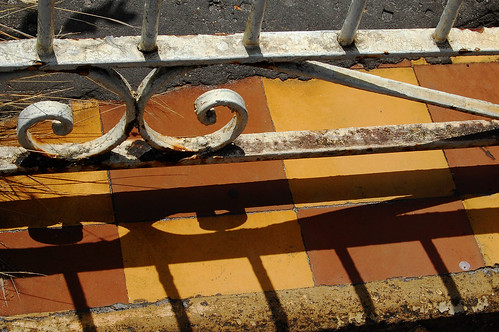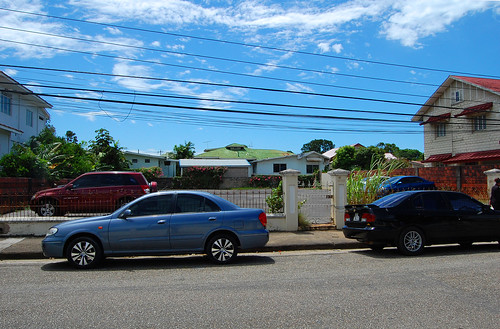
"Tile in the Car Park" shows the tile work (probably) left over from a house that once occupied the same space where the car park is now situated.
While walking along the streets of Port of Spain, we come across a seemingly normal space: a parking lot. Nowadays it is normal to see car parks, but has anyone ever stopped to wonder what used to occupy this very space? Highly doubtful. I've been told that Trinidadians like to live in the moment, in the present, with little focus on the past or future. With that ideology, I really don't expect many people to notice the odd usage of this space. Honestly, I too walked blindingly past the parking lot the first time and if it weren't for my mentor I would never have known the difference.
Christopher Cozier made sense of it, he explained that some quintessential pieces of architecture are being destroyed and, in its place, car parks or office buildings are created. I do not know what it is, whether people cannot afford to keep the house in working condition or if they are just selling it for the large sums of money. Maybe people are fed up trying to salvage a rotten house. Perhaps it is easier for the owners to give up the homes, but for what? More wealth, which would be spent paying off the higher electricity bill because of the overuse of air conditioning? Either way these culturally symbolic homes are being wiped out.
Some may argue that it's more beneficial for the community to have space for parking as opposed to having a worn down house. After seeing the spontaneous street parking (talk about creating space where none is provided) it is not a wonder why car parks are necessary. In some cases, cars would park facing the opposite directions on the same side of the street. For this and many more reasons, putting down concrete where a house used to be is necessary for the foward movement of Trinidad, or so it is believed. To any unsuspecting passerby, the parking lot was a great way to clear up the road for moving cars.

Here are "Opposite Facing Cars" parked on the street, not in the car park, still taking up road needed for driving.

Here are "Opposite Facing Cars" parked on the street, not in the car park, still taking up road needed for driving.
This particular car park is on St. Clair. It is situated between three houses, one on the left, right and behind it. I guess this isn't a huge difference, but I am accustomed seeing parking lots next to stores or at least down the street. Maybe I must have missed the store, but as far as I know, there was none immediately close by. To me, just the fact that the car park is an empty area between houses hints at the previous domestic use of the space.
The second piece of evidence eluding to this theory is the fence in front of the car park. The details and design of the fence is, if nothing else, reminiscent of the old types (which are scarcely found in Port of Spain). Assuming that iron rusts after a long period of time, it's possible that the fence has been standing for many years and still is even though the house it once enclosed is gone.
Finally, the final clue is the tile under the fence. It gives away the previous use of the space because it stands out the most. The tile work adds a hint of unique beauty to the otherwise plain looking car park. Tiling was and, probably still is, popular in homes, so the fact that tile is under the fence really gets the point across. Maybe people don't want to live in the past, but why not demolish the whole site instead of leaving these historically insignificant objects to taunt Trinidadians who actually remember.
Although I say insignificant, which does no justice to my sentiments about the space, what I really mean to say is that the non-existent physical structure could have expressed a story or revealed some sort of history. The architecture could have been a great way to keep Trinidad's culture and heritage alive, but it's a bit too late for those hopes. All that is left are these easily forgotten, quick to walk past with no second thought, objects that imply a deeper meaning.
For more Car Park pictures CLICK HERE
0 comments:
Post a Comment